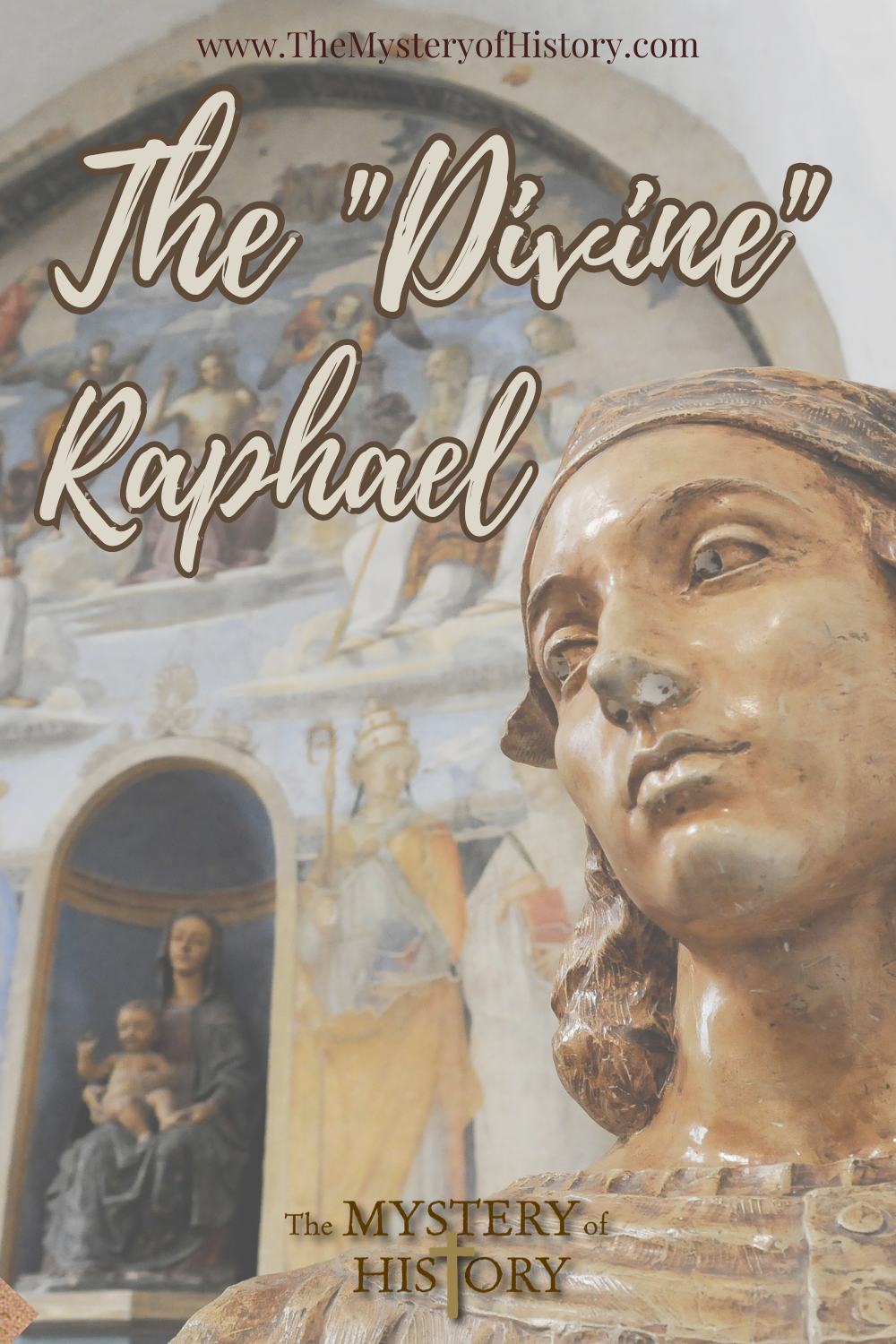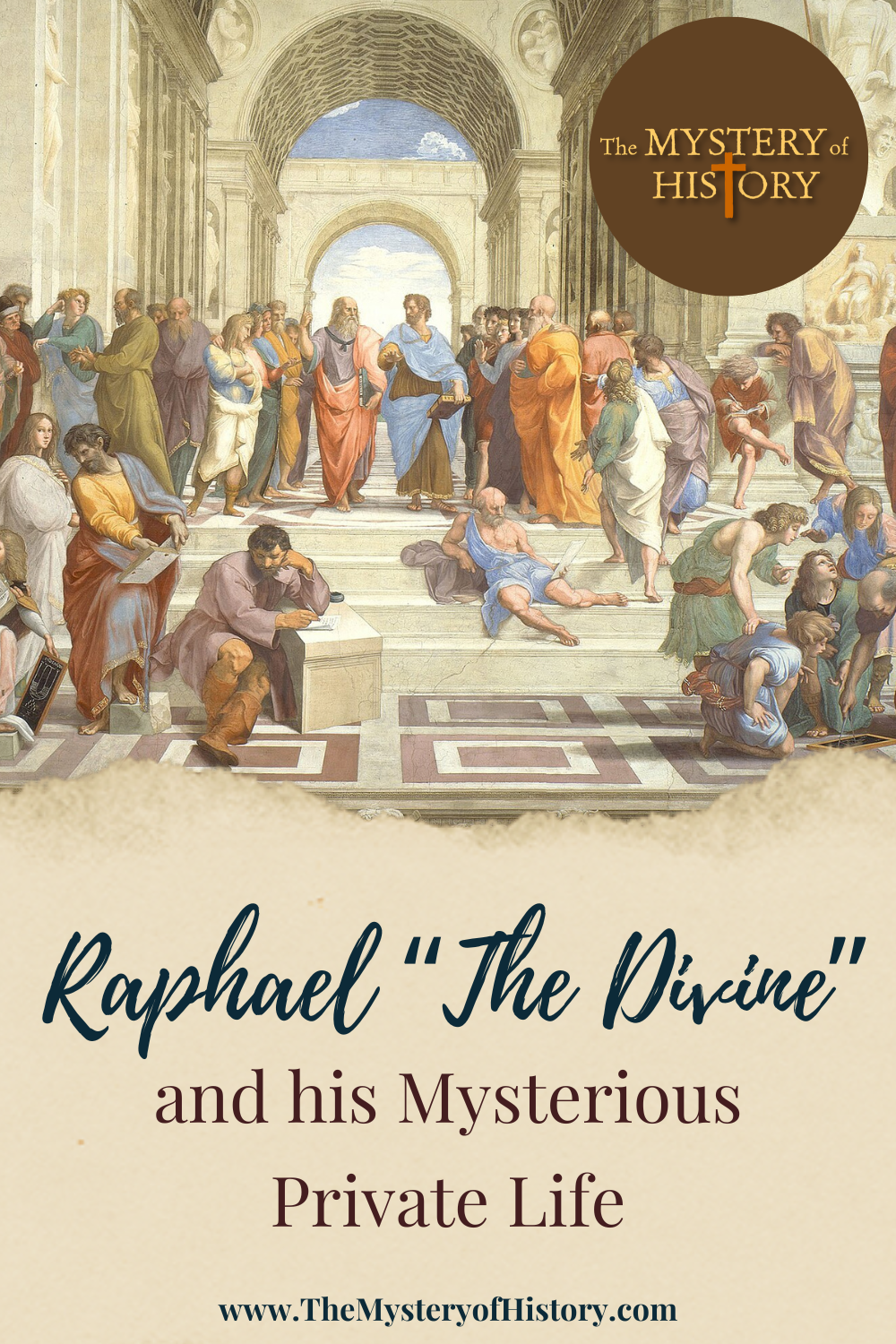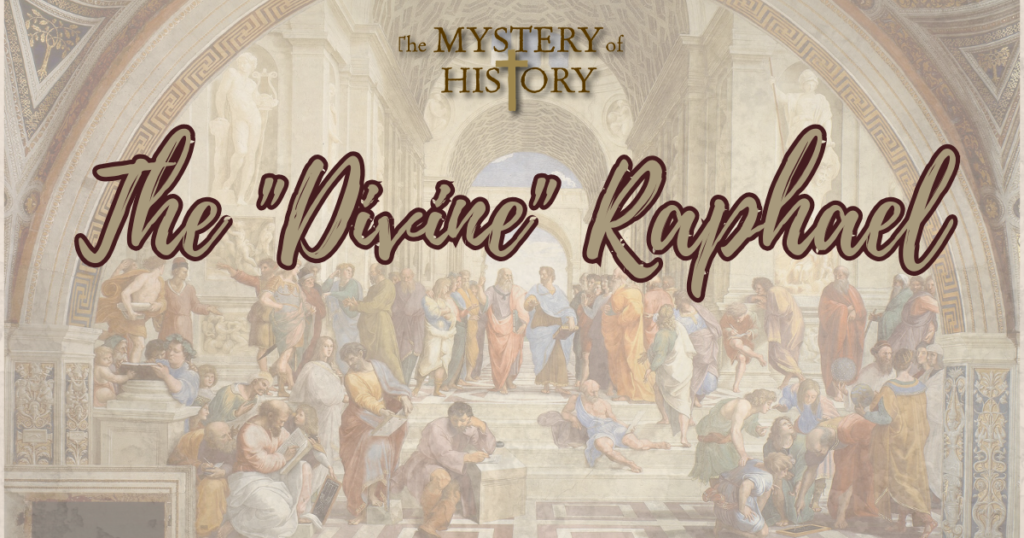Raphael was one of the most promising artists of the Renaissance. His art not only shows unusual skill and talent but also shows the very core ideas and concepts of the Renaissance—which was steeped in humanism. His story also contains some mystery! Let’s dive in, shall we?

Raphael’s full name is Rafaello Sanzio. He was born in Urbino, a city in the Papal States of Italy. He first learned to paint from his father, who died when Raphael was just 11 years old. He was later sent to study under an artist named Perugino (Peh rue JEE no). Under Perugino, Raphael became so good that to this day some people mistake his works for Perugino’s. While Perugino was away, Raphael painted in his place—and his fame grew. By 1504, Raphael moved to Florence, where he could learn from the best. He soon became known as the “Divine Raphael.”
You have probably seen a sample of Raphael’s work and not even known it. I’m referring to the image of two little cherubs, gazing with longing in their eyes into the distance. Legend says that Raphael painted the two after seeing some poor street children lean against the window of a bakery—dreaming of treats! (He was probably visiting the baker’s daughter, but more on her later.)
Pope Julius II
Raphael’s talent was soon recognized by Pope Julius II. This is the same pope who asked Michelangelo to paint the ceiling of the Sistine chapel. Julius was an impatient man and very demanding, but he did have vision. Pope Julius knew that to put that vision into reality, he would need the best of the best artists. And that included the young Raphael.
Pope Julius asked Raphael to paint his private chambers. He started by painting the room called Stanza della Segnatura (dee la See na CHUR uh). That’s Italian for the “Room of Signatures.” It was called this because the pope used this room to sign important papers. This room also contained the pope’s private library. On one wall were his books on theology; on another wall, were his book on philosophy.
On the wall dedicated to theology, Raphael painted a scene titled Disputa, or The Dispute of the Sacrament. It was Like a “Who’s Who of the Bible.” It includes Bible characters such as Abraham, Moses, David, Peter, and Paul. Below them are gathered great theologians, such as Jerome, Augustine, Aquinas, and Savonarola. It’s a stunning collage marking the fame of bible characters and church leaders.
On the wall dedicated to philosophy, Raphael painted a far more famous scene titled School of Athens. Before I describe it, I want to tell you a story. Before Raphael came to Rome, there was a sermon preached in the Sistine Chapel. In that sermon, the preacher praised Pope Julius II for bringing the best of learning to Rome. The preacher said, “You, now, Julius II … have founded a new Athens when you summon up that . . . world of letters as if raising it from the dead”1
What does that mean? Well, at that time in history, the Roman Church had strongly embraced the Renaissance way of thinking. It was not just seen in the minds of the humanists, but it was in the minds of church leaders, too—who were looking for acceptance from the world rather than from God. Raphael perfectly captured this Renaissance “way of thinking” in this painting. The church was embracing humanism (more than it should) and blending ancient thought with theology. Now, back to the masterpiece!
In School of Athens, Raphael brought together more than 50 classic thinkers of the past. And what makes it more interesting is whom Raphael painted some characters to look like. In some cases, he used fellow artists as models, as well as himself. (To be clever, Raphael painted himself as a young man looking straight at the viewer.) As for his fellow artists, in the very middle of the scene, Raphael painted Plato walking along Aristotle. His model for Plato was none other than Leonardo da Vinci with long flowing hair and beard, the greatest genius of the time. But there’s more.
After Raphael saw half of the Sistine Chapel ceiling completed, it inspired him to go back and add Heraclitus to School of Athens—alone on some steps. Why? Well, in history, Heraclitus was a grumpy philosopher who hardly got along with anyone. He must have reminded Raphael of the temperamental Michelangelo. So, as either an insult or a compliment, Raphael modeled Heraclitus after him! The figure is wearing boots just like Michelangelo’s. It was well known that Michelangelo was contentious. One time Michelangelo and Raphael passed each other in the Vatican. Michelangelo scoffed, saying, “You with your band, like a bravo.” Raphael retorted, “And you alone, like the hangman.”2 They were not good friends!

Raphael’s Mysterious Private Life
Except for his rivalry with Michelangelo, Raphael got along with almost everyone. He was charming and sociable. Giorgio Vasari said of Raphael, “He was never seen to go to court without having with him … some fifty painters, all able and excellent, who kept him company…”3
But the private life of Raphael remains a bit of a mystery. A powerful cardinal insisted that Raphael marry his niece, Maria. Raphael agreed to the engagement but kept coming up with excuses to put off the wedding. Some think he was already secretly engaged to a woman named Margherita Luti. (She was the daughter of a baker, who likely inspired his painting of the street children that he made into little angels!)
Though Raphael was publicly engaged, he wouldn’t commit to marrying Maria or Margherita. Perhaps he simply didn’t want to be tied down. But something lies in one of Raphael’s paintings that gives us a clue of his dilemma. Hundreds of years after one of Raphael’s paintings of Margherita was made, X-ray analysis showed that a large ruby ring was originally painted on her finger. What is an engagement ring—that was covered up? It is believed that Raphael (or one of his pupils) painted over the ring to keep it a secret. Ha! Raphael may have been privately and publicly engaged. We don’t know for sure.
Sadly enough, Maria, Raphael’s official fiancée, died before they could settle on a wedding date. Maybe Maria died of a broken heart, knowing she wasn’t really loved. Soon after her death, Raphael died too. He was only 37! The exact cause of death is unknown, but he lived long enough to distribute his wealth to Margherita, who lived the rest of her life in a convent. Raphael died on the same date that he was born, April 6. He was buried next to Maria, who in the end, was next to her man. It is tragic that Raphael died so young. Had he lived longer, the world would surely have more of his masterpieces, and perhaps the mystery of his engagement would have been revealed.
1. Ross King, Michelangelo and the Pope’s Ceiling. (New York: Walker and Co., 2003), 180.
2. Ibid., 182.
3. Ibid.
Activities
All Students—A Who’s Who Collage of Historical Figures
Materials: printed images of historical figures, glue, scissors, paper
1. Similar to Raphael in School of Athens, try to create a collage of people you like from any era in history
2.. Print out images from the internet of your favorite historical figures (older students can try sketching them freehand).
3. Cut them out and glue them to a sheet of paper, drawing or adding background elements as you go. Make your scene as complex or as simple as you like!



